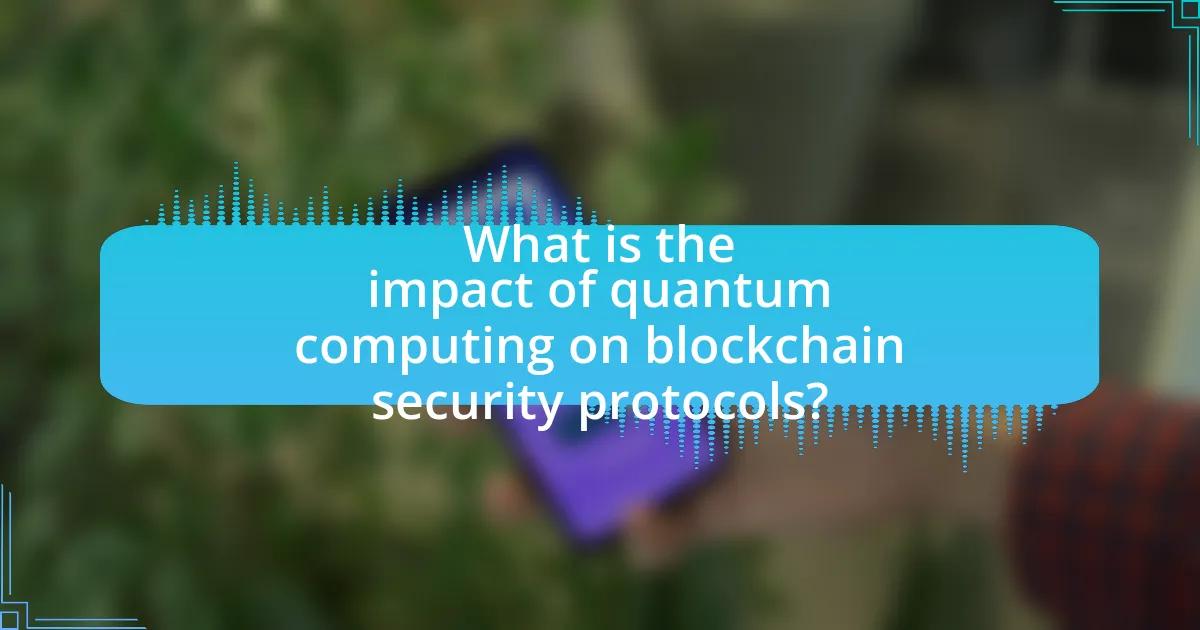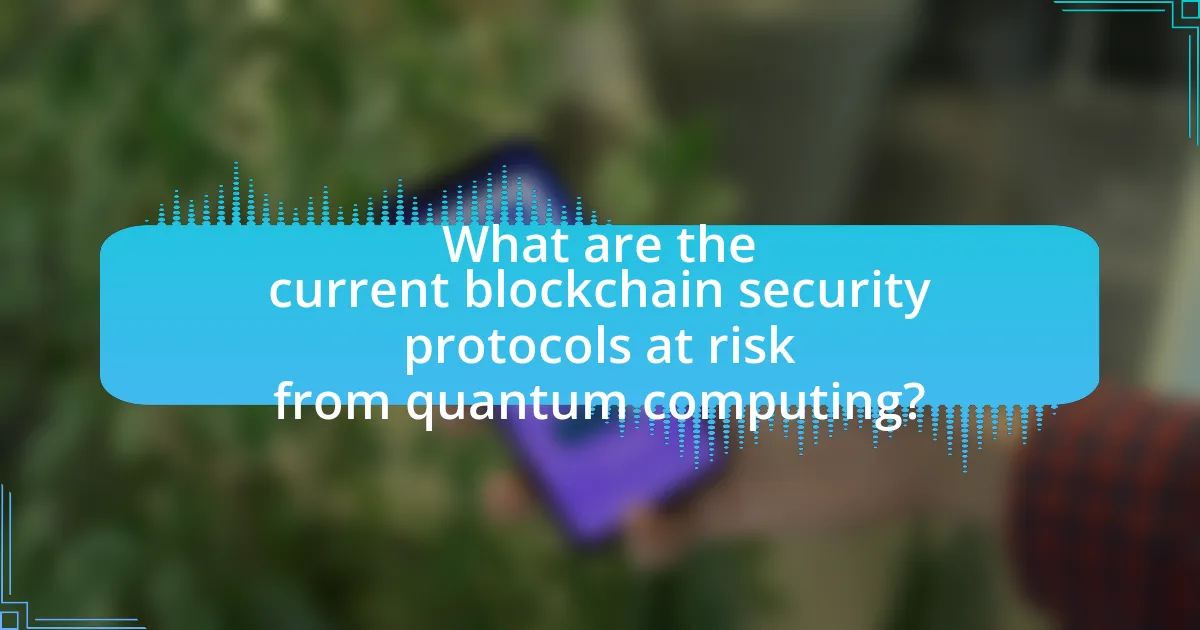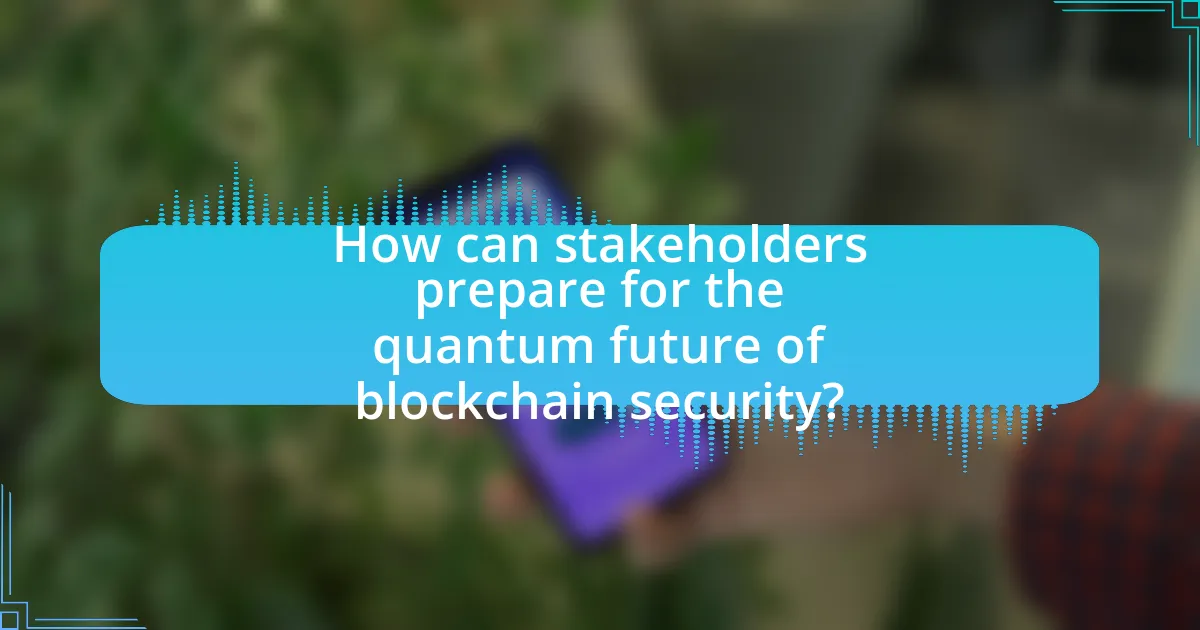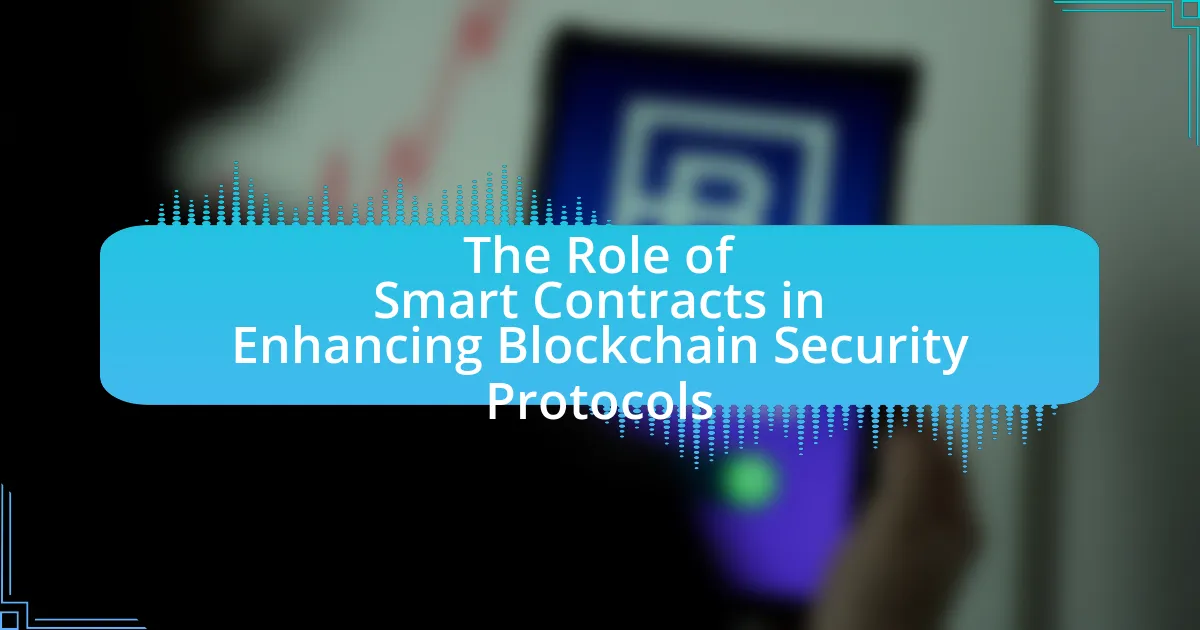The article examines the impact of quantum computing on blockchain security protocols, highlighting the vulnerabilities introduced by quantum algorithms that can break traditional cryptographic techniques such as RSA and ECC. It discusses how quantum computing challenges existing security measures, the specific risks to blockchain integrity, and the urgent need for quantum-resistant cryptographic protocols. Additionally, the article outlines current blockchain security protocols at risk, the role of public-key cryptography, and strategies for organizations to safeguard their systems against potential quantum threats. It emphasizes the importance of understanding these developments to ensure the future security of blockchain technology.

What is the impact of quantum computing on blockchain security protocols?
Quantum computing poses a significant threat to blockchain security protocols by potentially breaking the cryptographic algorithms that secure transactions and data. Traditional blockchain systems rely on cryptographic techniques such as SHA-256 and elliptic curve cryptography, which are currently considered secure against classical computing attacks. However, quantum computers can leverage algorithms like Shor’s algorithm to efficiently factor large numbers and compute discrete logarithms, rendering these cryptographic methods vulnerable. Research indicates that a sufficiently powerful quantum computer could compromise the integrity and confidentiality of blockchain networks, leading to unauthorized access and manipulation of data.
How does quantum computing challenge existing blockchain security measures?
Quantum computing poses a significant challenge to existing blockchain security measures primarily due to its ability to efficiently solve complex mathematical problems that underpin cryptographic algorithms. Traditional blockchain security relies on cryptographic techniques such as SHA-256 and ECDSA, which are currently secure against classical computing attacks. However, quantum computers can utilize algorithms like Shor’s algorithm to factor large integers and compute discrete logarithms exponentially faster than classical computers, potentially compromising the security of public-key cryptography used in blockchain systems. For instance, a sufficiently powerful quantum computer could break the cryptographic keys of Bitcoin and Ethereum, allowing malicious actors to forge transactions or manipulate the blockchain. This vulnerability highlights the urgent need for the development of quantum-resistant cryptographic protocols to safeguard blockchain technology against future quantum threats.
What specific vulnerabilities does quantum computing introduce to blockchain technology?
Quantum computing introduces specific vulnerabilities to blockchain technology primarily through its ability to break cryptographic algorithms that secure blockchain transactions. For instance, quantum computers can efficiently solve problems that are currently infeasible for classical computers, such as factoring large integers and computing discrete logarithms, which underpin the security of widely used cryptographic protocols like RSA and ECDSA. This capability threatens the integrity of digital signatures and public key infrastructures, potentially allowing malicious actors to forge transactions or compromise private keys. Research indicates that a sufficiently powerful quantum computer could undermine the security of blockchain networks, as demonstrated by studies from institutions like the University of Sussex, which highlight the risks posed by quantum algorithms to existing cryptographic systems.
How do quantum algorithms threaten cryptographic techniques used in blockchain?
Quantum algorithms threaten cryptographic techniques used in blockchain primarily by enabling the efficient factorization of large integers and the computation of discrete logarithms, which underlie many cryptographic protocols. For instance, Shor’s algorithm can break RSA and ECC (Elliptic Curve Cryptography) by solving these problems in polynomial time, whereas classical algorithms require exponential time. This capability poses a significant risk to blockchain security, as many blockchain systems rely on these cryptographic methods for securing transactions and maintaining consensus. The potential for quantum computers to compromise these cryptographic techniques necessitates the development of quantum-resistant algorithms to safeguard blockchain integrity.
Why is it important to understand the intersection of quantum computing and blockchain?
Understanding the intersection of quantum computing and blockchain is crucial because quantum computing has the potential to undermine the cryptographic security that underpins blockchain technology. Quantum computers can efficiently solve problems that are currently infeasible for classical computers, such as factoring large integers and computing discrete logarithms, which are foundational to blockchain security protocols like RSA and ECC. For instance, a sufficiently powerful quantum computer could break these cryptographic algorithms in a matter of hours, rendering existing blockchain systems vulnerable to attacks. This understanding is essential for developing quantum-resistant cryptographic methods to ensure the future security and integrity of blockchain networks.
What are the potential consequences of quantum attacks on blockchain systems?
Quantum attacks on blockchain systems can lead to significant vulnerabilities, primarily by compromising cryptographic algorithms that secure transactions and user identities. For instance, quantum computers can efficiently solve problems like integer factorization and discrete logarithms, which underpin the security of widely used algorithms such as RSA and ECDSA. This capability could allow attackers to forge signatures, reverse transactions, or steal private keys, undermining the integrity and trustworthiness of blockchain networks. Research indicates that as quantum computing technology advances, the risk of such attacks increases, necessitating the development of quantum-resistant cryptographic protocols to safeguard blockchain systems.
How can the evolution of quantum computing influence the future of blockchain security?
The evolution of quantum computing can significantly undermine blockchain security by enabling the decryption of cryptographic algorithms currently used to secure blockchain transactions. Quantum computers, leveraging principles of quantum mechanics, can perform calculations at speeds unattainable by classical computers, particularly through algorithms like Shor’s algorithm, which can factor large integers efficiently. This capability threatens the widely used public-key cryptography, such as RSA and ECC, which underpins the security of blockchain networks. For instance, a sufficiently powerful quantum computer could potentially break the cryptographic keys of Bitcoin, allowing unauthorized access to wallets and transactions. As a result, the blockchain community is actively researching quantum-resistant algorithms to safeguard against these vulnerabilities, highlighting the urgent need for adaptive security measures in the face of advancing quantum technology.

What are the current blockchain security protocols at risk from quantum computing?
Current blockchain security protocols at risk from quantum computing include those based on public-key cryptography, such as RSA and ECC (Elliptic Curve Cryptography). Quantum computers can potentially break these cryptographic systems using algorithms like Shor’s algorithm, which can efficiently factor large integers and compute discrete logarithms, undermining the security of transactions and data integrity in blockchain networks. The vulnerability of these protocols has been highlighted in various studies, including research by the National Institute of Standards and Technology (NIST), which is actively working on post-quantum cryptography standards to address these risks.
Which cryptographic algorithms are most vulnerable to quantum attacks?
The cryptographic algorithms most vulnerable to quantum attacks include RSA, DSA, and ECC (Elliptic Curve Cryptography). These algorithms rely on mathematical problems that quantum computers can solve efficiently using Shor’s algorithm, which can factor large integers and compute discrete logarithms in polynomial time. For instance, RSA’s security is based on the difficulty of factoring the product of two large prime numbers, a task that becomes feasible for quantum computers, rendering RSA insecure. Similarly, ECC’s security hinges on the difficulty of the elliptic curve discrete logarithm problem, which is also vulnerable to quantum algorithms.
What role does public-key cryptography play in blockchain security?
Public-key cryptography is essential for blockchain security as it enables secure transactions and user authentication. In blockchain systems, each user possesses a unique public-private key pair; the public key is shared while the private key remains confidential. This mechanism ensures that only the owner of the private key can authorize transactions, thereby preventing unauthorized access and fraud. Furthermore, public-key cryptography facilitates the creation of digital signatures, which verify the integrity and authenticity of transactions on the blockchain. The reliance on these cryptographic principles is critical for maintaining trust and security in decentralized networks, especially as quantum computing poses potential threats to traditional cryptographic methods.
How does quantum computing specifically affect hashing algorithms used in blockchain?
Quantum computing poses a significant threat to hashing algorithms used in blockchain by potentially enabling faster computation of hash functions, which could compromise the integrity and security of blockchain systems. Traditional hashing algorithms, such as SHA-256, rely on the computational difficulty of reversing the hash function to ensure security; however, quantum computers can utilize Grover’s algorithm to search through possible inputs at a quadratic speedup, effectively reducing the security level of these algorithms. For instance, while SHA-256 would typically require 2^256 operations to brute-force, a quantum computer could theoretically achieve this in about 2^128 operations, making it feasible for attackers to find collisions or pre-images. This vulnerability necessitates the exploration of quantum-resistant hashing algorithms to maintain blockchain security in a post-quantum world.
What measures are being taken to enhance blockchain security against quantum threats?
To enhance blockchain security against quantum threats, researchers and developers are implementing post-quantum cryptography (PQC) algorithms. These algorithms are designed to be secure against the potential capabilities of quantum computers, which could break traditional cryptographic methods like RSA and ECC. For instance, the National Institute of Standards and Technology (NIST) is actively working on standardizing PQC algorithms, with several candidates already selected for further evaluation. Additionally, blockchain platforms are exploring hybrid models that combine classical and quantum-resistant algorithms to ensure security during the transition period. These measures are crucial as quantum computing technology continues to advance, posing a significant risk to existing blockchain security frameworks.
What is post-quantum cryptography and how does it relate to blockchain?
Post-quantum cryptography refers to cryptographic algorithms designed to be secure against the potential threats posed by quantum computers. These algorithms are essential for maintaining the integrity and security of data, particularly in systems like blockchain, which rely on traditional cryptographic methods that could be vulnerable to quantum attacks. For instance, quantum computers could potentially break widely used public-key cryptosystems, such as RSA and ECC, which are foundational to blockchain security. Therefore, integrating post-quantum cryptographic techniques into blockchain protocols is crucial to ensure that these systems remain secure in a future where quantum computing is prevalent.
How are blockchain developers adapting to the challenges posed by quantum computing?
Blockchain developers are adapting to the challenges posed by quantum computing by implementing quantum-resistant cryptographic algorithms. These algorithms, such as lattice-based, hash-based, and multivariate polynomial cryptography, are designed to withstand the potential threats posed by quantum algorithms like Shor’s algorithm, which can efficiently factor large integers and compute discrete logarithms, undermining traditional cryptographic methods. Research from the National Institute of Standards and Technology (NIST) is guiding these efforts, as they are in the process of standardizing post-quantum cryptographic algorithms to ensure long-term security for blockchain systems.

How can stakeholders prepare for the quantum future of blockchain security?
Stakeholders can prepare for the quantum future of blockchain security by adopting quantum-resistant cryptographic algorithms. These algorithms, such as lattice-based, hash-based, and code-based cryptography, are designed to withstand the computational power of quantum computers, which can potentially break traditional cryptographic methods like RSA and ECC. Research indicates that transitioning to quantum-resistant algorithms is essential, as the National Institute of Standards and Technology (NIST) is actively working on standardizing post-quantum cryptography to ensure security against quantum threats. By implementing these advanced cryptographic techniques, stakeholders can enhance the resilience of blockchain systems against future quantum attacks.
What strategies can organizations implement to safeguard their blockchain systems?
Organizations can implement several strategies to safeguard their blockchain systems, including adopting quantum-resistant cryptographic algorithms, enhancing access controls, and conducting regular security audits. Quantum-resistant cryptographic algorithms, such as lattice-based or hash-based signatures, are designed to withstand potential threats posed by quantum computing, which could break traditional cryptographic methods. Strengthening access controls through multi-factor authentication and role-based permissions helps prevent unauthorized access to blockchain networks. Additionally, conducting regular security audits allows organizations to identify vulnerabilities and ensure compliance with security standards, thereby reinforcing the overall integrity of their blockchain systems.
How can businesses assess their current blockchain security posture against quantum risks?
Businesses can assess their current blockchain security posture against quantum risks by conducting a comprehensive risk assessment that evaluates their cryptographic algorithms and protocols. This assessment should include identifying the specific blockchain technologies in use, analyzing their susceptibility to quantum attacks, and determining the potential impact of such vulnerabilities on their operations.
For instance, organizations can utilize frameworks like the National Institute of Standards and Technology (NIST) guidelines, which provide a roadmap for transitioning to quantum-resistant algorithms. Additionally, businesses can engage in penetration testing and simulations to evaluate how their systems would withstand quantum threats.
Research indicates that quantum computers could potentially break widely used cryptographic schemes, such as RSA and ECC, within the next decade, making it crucial for businesses to proactively assess and adapt their security measures. By staying informed about advancements in quantum computing and regularly updating their security protocols, businesses can better prepare for the evolving landscape of quantum risks.
What best practices should be adopted for transitioning to quantum-resistant protocols?
To transition to quantum-resistant protocols, organizations should adopt a multi-faceted approach that includes assessing current cryptographic systems, selecting appropriate quantum-resistant algorithms, and implementing a phased migration strategy. Assessing current systems involves identifying vulnerabilities in existing cryptographic methods that quantum computers could exploit, such as RSA and ECC. Selecting quantum-resistant algorithms, such as those based on lattice-based, hash-based, or code-based cryptography, is crucial, as these have been recognized by the National Institute of Standards and Technology (NIST) in their ongoing post-quantum cryptography standardization process. Implementing a phased migration strategy allows organizations to gradually replace vulnerable systems while ensuring compatibility and minimizing disruption. This approach is supported by NIST’s recommendations, which emphasize the importance of preparing for quantum threats well in advance to safeguard sensitive data and maintain security integrity.
What resources are available for further understanding quantum computing’s impact on blockchain?
Resources for understanding quantum computing’s impact on blockchain include academic papers, online courses, and industry reports. Notable academic papers such as “Quantum Computing and Blockchain: A Survey” by A. K. S. S. R. K. Reddy et al. provide insights into the intersection of these technologies. Online platforms like Coursera and edX offer courses on quantum computing that often touch on its implications for blockchain. Additionally, industry reports from organizations like the World Economic Forum discuss the potential vulnerabilities quantum computing poses to blockchain security. These resources collectively enhance comprehension of how quantum advancements may affect blockchain protocols.
Where can stakeholders find updated research and developments in quantum blockchain security?
Stakeholders can find updated research and developments in quantum blockchain security through academic journals, industry conferences, and specialized online platforms. Notable sources include the IEEE Xplore Digital Library, which publishes peer-reviewed articles on quantum computing and blockchain technology, and the International Journal of Quantum Information, which features research on quantum security protocols. Additionally, conferences such as the Quantum Blockchain Summit provide insights into the latest advancements and networking opportunities with experts in the field. These platforms consistently offer credible and current information, ensuring stakeholders stay informed about the evolving landscape of quantum blockchain security.
What communities or forums focus on the intersection of quantum computing and blockchain technology?
Communities and forums that focus on the intersection of quantum computing and blockchain technology include the Quantum Computing Stack Exchange, which allows users to discuss technical aspects and implications of quantum computing on various fields, including blockchain. Additionally, the Blockchain and Quantum Computing group on LinkedIn serves as a networking platform for professionals interested in the convergence of these technologies. The Quantum Blockchain Forum is another dedicated space where researchers and enthusiasts share insights and developments related to both fields. These platforms facilitate knowledge exchange and collaboration among experts, thereby enhancing understanding of how quantum computing may impact blockchain security protocols.

















